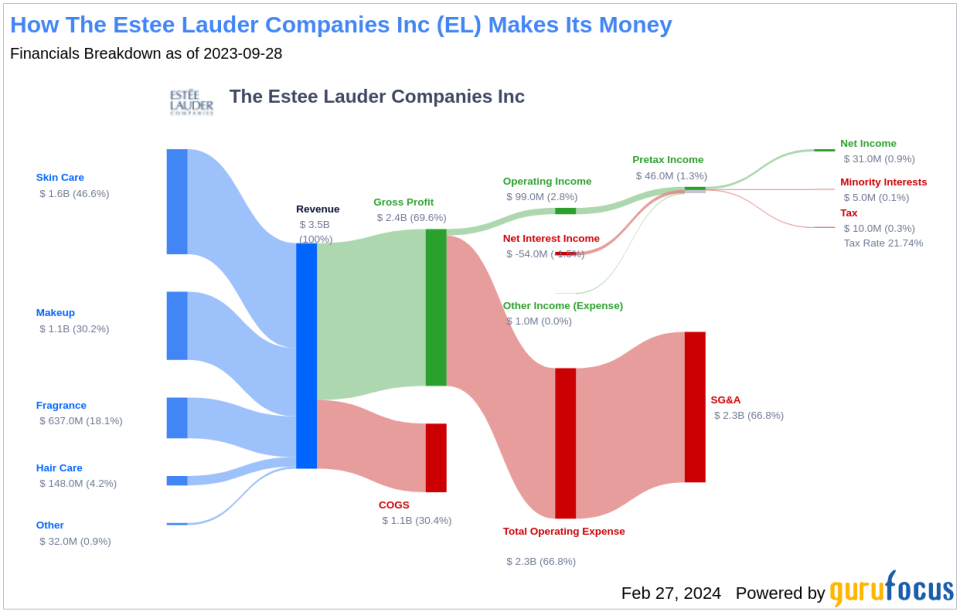The Estee Lauder Companies Inc's Dividend Analysis
Assessing the Beauty Giant's Dividend Prowess
The Estee Lauder Companies Inc(NYSE:EL) recently announced a dividend of $0.66 per share, payable on 2024-03-15, with the ex-dividend date set for 2024-02-28. As investors look forward to this upcoming payment, the spotlight also shines on the company's dividend history, yield, and growth rates. Using the data from GuruFocus, let's look into The Estee Lauder Companies Inc's dividend performance and assess its sustainability.
What Does The Estee Lauder Companies Inc Do?
This Powerful Chart Made Peter Lynch 29% A Year For 13 Years
How to calculate the intrinsic value of a stock?
The Estee Lauder Companies Inc is a leader in the global prestige beauty market, participating across skin care (52% of 2023 sales), makeup (28%), fragrance (16%), and hair care (4%) categories, with top-selling brands such as Estee Lauder, Clinique, M.A.C, La Mer, Jo Malone London, Aveda, Bobbi Brown, and Origins. The firm operates in more than 150 countries, generating 28% of revenue from the Americas, 39% from Europe, the Middle East and Africa (including travel retail), and 33% from Asia-Pacific. Estee Lauder sells its products through department stores, travel retail, specialty multibrand beauty stores, brand-dedicated freestanding stores, e-commerce, salons/spas, and perfumeries.
A Glimpse at The Estee Lauder Companies Inc's Dividend History
The Estee Lauder Companies Inc has maintained a consistent dividend payment record since 1996. Dividends are currently distributed on a quarterly basis. Below is a chart showing annual Dividends Per Share for tracking historical trends.
Breaking Down The Estee Lauder Companies Inc's Dividend Yield and Growth
As of today, The Estee Lauder Companies Inc currently has a 12-month trailing dividend yield of 1.81% and a 12-month forward dividend yield of 1.81%. This suggests an expectation of the same dividend payments over the next 12 months.
Over the past three years, The Estee Lauder Companies Inc's annual dividend growth rate was 22.90%. Extended to a five-year horizon, this rate decreased to 12.70% per year. And over the past decade, The Estee Lauder Companies Inc's annual dividends per share growth rate stands at an impressive 11.30%.
Based on The Estee Lauder Companies Inc's dividend yield and five-year growth rate, the 5-year yield on cost of The Estee Lauder Companies Inc stock as of today is approximately 3.29%.
The Sustainability Question: Payout Ratio and Profitability
To assess the sustainability of the dividend, one needs to evaluate the company's payout ratio. The dividend payout ratio provides insights into the portion of earnings the company distributes as dividends. A lower ratio suggests that the company retains a significant part of its earnings, thereby ensuring the availability of funds for future growth and unexpected downturns. As of 2023-12-31, The Estee Lauder Companies Inc's dividend payout ratio is 1.73, which may suggest that the company's dividend may not be sustainable.
The Estee Lauder Companies Inc's profitability rank, offers an understanding of the company's earnings prowess relative to its peers. GuruFocus ranks The Estee Lauder Companies Inc's profitability 9 out of 10 as of 2023-12-31, suggesting good profitability prospects. The company has reported positive net income for each year over the past decade, further solidifying its high profitability.
Growth Metrics: The Future Outlook
To ensure the sustainability of dividends, a company must have robust growth metrics. The Estee Lauder Companies Inc's growth rank of 9 out of 10 suggests that the company's growth trajectory is good relative to its competitors.
Revenue is the lifeblood of any company, and The Estee Lauder Companies Inc's revenue per share, combined with the 3-year revenue growth rate, indicates a strong revenue model. The Estee Lauder Companies Inc's revenue has increased by approximately 4.20% per year on average, a rate that underperforms than approximately 58.94% of global competitors.
The company's 3-year EPS growth rate showcases its capability to grow its earnings, a critical component for sustaining dividends in the long run. During the past three years, The Estee Lauder Companies Inc's earnings increased by approximately -5.70% per year on average, a rate that underperforms than approximately 65.45% of global competitors.
Lastly, the company's 5-year EBITDA growth rate of 0.10%, which underperforms than approximately 63.01% of global competitors.
Next Steps
In conclusion, The Estee Lauder Companies Inc's dividend payments, with a history of consistent payouts since 1996, reflect a shareholder-friendly approach. However, the sustainability of its dividend is under scrutiny due to a high payout ratio and mixed growth metrics. While The Estee Lauder Companies Inc exhibits strong profitability, the company's revenue and earnings growth rates have underperformed a majority of global competitors. This mixed picture suggests that investors should closely monitor the company's financial health and growth prospects when considering its dividend reliability. For those seeking dividend-paying stocks, GuruFocus Premium users can screen for high-dividend yield stocks using the High Dividend Yield Screener.
This article, generated by GuruFocus, is designed to provide general insights and is not tailored financial advice. Our commentary is rooted in historical data and analyst projections, utilizing an impartial methodology, and is not intended to serve as specific investment guidance. It does not formulate a recommendation to purchase or divest any stock and does not consider individual investment objectives or financial circumstances. Our objective is to deliver long-term, fundamental data-driven analysis. Be aware that our analysis might not incorporate the most recent, price-sensitive company announcements or qualitative information. GuruFocus holds no position in the stocks mentioned herein.
This article first appeared on GuruFocus.


